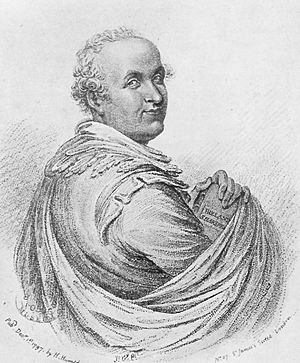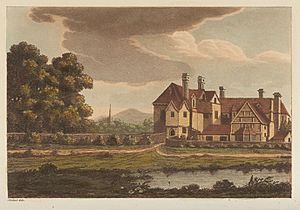Samuel Ireland facts for kids
Samuel Ireland (born 1744, died 1800) was an English writer and artist. He is mostly known today because his son, William Henry Ireland, created fake Shakespeare documents that tricked many people, including Samuel himself.
Contents
Early Life and Art Skills
Samuel Ireland started his working life as a weaver in Spitalfields, London. But he soon found a passion for buying and selling old prints and drawings. In his free time, he taught himself how to draw, etch, and engrave. He became quite good at it, even winning a medal from the Society of Arts in 1760.
He showed his artwork at the Royal Academy in 1784. He also created many etchings (a type of printmaking) based on the works of famous artists like Hogarth. Some of his own etched portraits are still kept in the British Museum today.
Samuel also loved collecting books, pictures, and interesting old items. In 1794, he published a book called "Graphic Illustrations of Hogarth." This book showed off some of the valuable Hogarth artworks he owned.
Travels and Scenic Books
In 1790, Samuel Ireland published a book about his travels called A Picturesque Tour through Holland, Brabant, and part of France. This book included his own drawings from the places he visited. He created a whole series of these "Picturesque Views" books, which were popular with collectors.
- Picturesque Views on the River Thames (1792)
- Picturesque Views on the River Medway (1793)
- Picturesque Views on the Warwickshire Avon (1795)
- Picturesque Views on the River Wye (1797)
Samuel Ireland lived in London with Mrs. Freeman and their children, William Henry and Jane. Jane was also an artist and painted small portraits.
Love for Shakespeare
Samuel Ireland was a huge fan of William Shakespeare. In 1793, while working on his book about the River Avon, he visited Stratford-upon-Avon, Shakespeare's hometown. He took his son, William Henry, with him. Samuel wanted to see all the places connected to the famous playwright.
He heard many local stories about Shakespeare. He even heard that some of Shakespeare's old papers had been moved from his home, New Place, to Clopton House during a fire. When Samuel went to Clopton House, he was told that the papers he was looking for had been destroyed just a week before! He was very disappointed.
The Fake Documents
In late 1794, Samuel's son, William Henry, claimed he had found an old paper signed by Shakespeare. William Henry said he got it from a mysterious friend. But actually, William Henry had forged (faked) the paper himself. He used blank parchment from an old document he found at his workplace.
Important experts thought the paper was real. Soon, William Henry "found" more items:
- A letter from Queen Elizabeth I
- A love poem by Shakespeare to his future wife, "Anna Hatherreway"
- The original handwritten copy of the play King Lear
- The handwritten copy of a new, unknown play called Vortigern and Rowena
These fake documents were put on display at Samuel Ireland's house. Many famous writers and scholars, like James Boswell, believed they were real. However, the leading Shakespeare experts, Edmond Malone and George Steevens, immediately said they were fakes.
Samuel Ireland truly believed the documents were real. He published them in a large book in December 1795. But the truth soon came out. Edmond Malone published a detailed book in March 1796 proving they were forgeries. The play Vortigern and Rowena was performed once and failed badly, which also helped show it was a fake.
Later Life and Reputation
Samuel Ireland was very upset by these events. Even though his son admitted to the forgeries in 1796, many people blamed Samuel. He tried to defend himself, saying he had no idea they were fake. He published a book called A Vindication of His Conduct in November 1796.
His reputation was badly damaged. In 1796, he was even made fun of in a play at Covent Garden. When he published his book about the River Wye in 1797, it didn't sell well, showing how much his reputation had fallen.
Samuel Ireland died in July 1800. His doctor said that Samuel declared on his deathbed that he knew nothing about the trick and believed the documents were real, just like everyone else who was fooled. He never made up with his son. After his death, his old books and collections were sold.
Samuel Ireland's Books
- A Picturesque Tour through Holland, Brabant, and part of France made in the Autumn of 1789, London, 1790
- Picturesque Views on the River Thames, 1792
- Picturesque Views on the River Medway, 1793
- Graphic Illustrations of Hogarth, 1794
- Picturesque Views on the Upper, or Warwickshire Avon, 1795
- Miscellaneous Paper and Legal Instruments under the Hand and Seal of William Shakespeare, London, 1796
- Mr. Ireland's Vindication of His Conduct Respecting the Publication of the Supposed Shakspeare MSS., London, 1796
- An Investigation of Mr. Malone's Claim to the Character of Scholar or Critic, 1797
- Picturesque Views on the River Wye, 1797
- Picturesque Views, with an Historical Account of the Inns of Court in London and Westminster, 1800
- Picturesque Views on the River Severn, 1824



